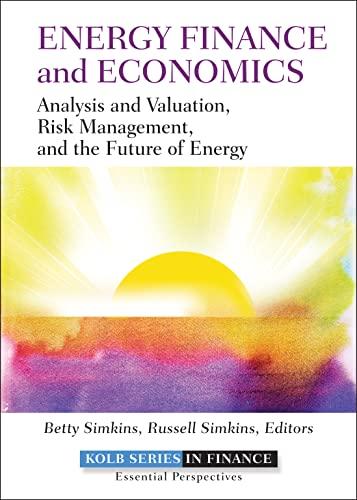Question
PLEASE ENTER ANSWERS IN BLUE BOLD INK ! Ann wants a mortgage to buy a house. Ann gives the following information to the bank: Income:
PLEASE ENTER ANSWERS IN BLUE BOLD INK!
Ann wants a mortgage to buy a house. Ann gives the following information to the bank:
Income: $240k/year or 20k/month
Average monthly debt: $2k
Estimated monthly Taxes + Insurance: $700
Down-payment: $50k saved
-Anns down-payment will be $50k, she will take out a mortgage for the remainder
Ann qualifies for a 30 year FA-CPM-FRM (monthly payments & monthly compounding) with:
Annual interest rate: 4%
Income test: (28%/36%)
Collateral test: LTV95%B019*DP0
Closing costs + buy-down points: $5,000 + 1.75% of the balance at origination.
-Example: if Ann gets a $100k mortgage, she will pay $5k + $1.75k=$6.75k at origination.
1 Underwriting
1.1: Fill in the spreadsheet (sheet Underwriting) for Ann.
1.2: based on the FE DTI what is the biggest payment Ann can make?
1.3: based on the BE DTI what is the biggest payment Ann can make?
1.4: based on both the FE & BE DTI what is the biggest payment Ann can make?
1.5: based on both the FE & BE DTI what is the biggest loan Ann can get?
1.6: based the LTV test and Anns $50k down-payment, what is the biggest loan Ann can get?
1.7: based on the income & collateral tests, what is the biggest loan Ann can get?
1.8: based on the income & collateral tests, what is the biggest payment Ann can make?
1.9: if Ann makes a 50k down-payment, how much house can Ann afford?
1.10: how much are Anns total mortgage closing costs?
Use the following information for the remaining questions.
Ann would like to buy a house.
It costs $2,500,000.
Her down payment will be $50,000.
She will take out a mortgage for the remainder.
It will be a 30 year, fully amortizing, FRM, with constant monthly payments and monthly compounding.
The annual interest rate is 4.00%.
She will pay $5,000 in closing costs at origination.
She will also pay 1.75% of the balance in buy-down points at origination.
Note: the home is bought and the loan is taken in month 0, the first payment is due in month 1.
In the spreadsheet where it says cash inflow, outflow and net cash flow you should only take into account cash flow related to the mortgage.
2. Fill in the spreadsheet (sheet FA AMORTIZATION SCHEDULE) for Ann.
(It is called an amortization schedule or amortization calendar.)
3. Compute Anns annualized IRR for the mortgage in the spreadsheet. (Use the net cash flow.)
(3.a) What is the annualized IRR for the mortgage?
(3.b) Is it higher or lower than the mortgage contract rate?
(3.c) Why?
4. Plot Anns mortgage balance in one graph. Place the graph here.
Step by Step Solution
There are 3 Steps involved in it
Step: 1

Get Instant Access to Expert-Tailored Solutions
See step-by-step solutions with expert insights and AI powered tools for academic success
Step: 2

Step: 3

Ace Your Homework with AI
Get the answers you need in no time with our AI-driven, step-by-step assistance
Get Started


